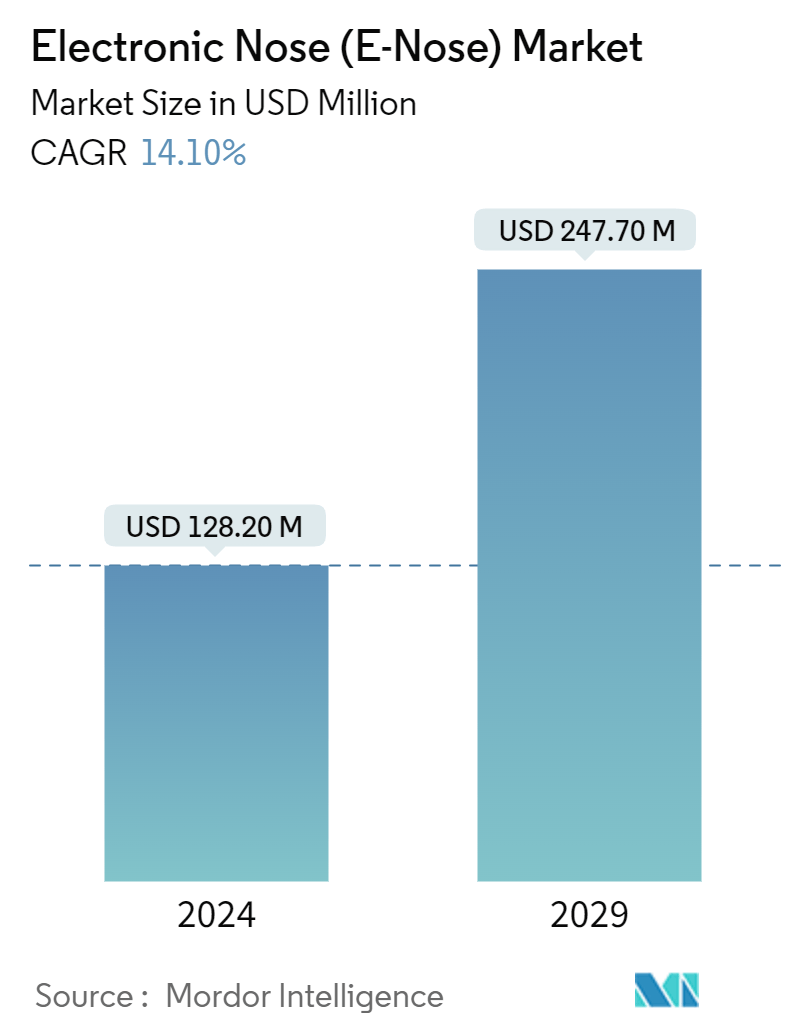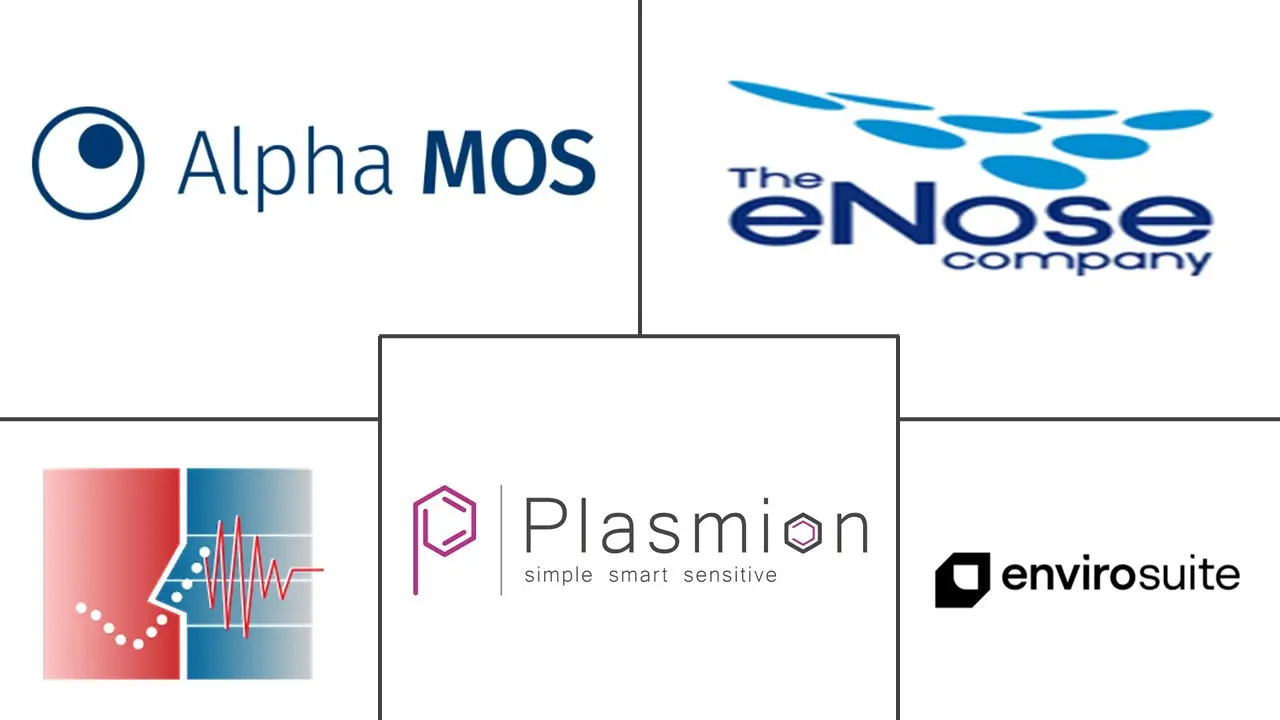Market Size of Electronic Nose (E-Nose) Industry

| Study Period | 2019 - 2029 |
| Market Size (2024) | USD 128.20 Million |
| Market Size (2029) | USD 247.70 Million |
| CAGR (2024 - 2029) | 14.10 % |
| Fastest Growing Market | Asia Pacific |
| Largest Market | North America |
Major Players
*Disclaimer: Major Players sorted in no particular order |
Electronic Nose Market Analysis
The Electronic Nose Market size is estimated at USD 128.20 million in 2024, and is expected to reach USD 247.70 million by 2029, growing at a CAGR of 14.10% during the forecast period (2024-2029).
An electronic nose is a technology utilized to explore biological olfactory function. It is used to distinguish complex volatiles, which can reproduce the structure and principle of the olfactory sense. With the development of society, the importance of olfactory application in the food industry, environmental detection, and medical treatment is increasing.
• The electronic nose has significant application value in identifying odors like wine, vegetables, cigarettes, etc. It is widely employed in odor detection, raw material inspection, quality signing, and sprinkling process management. It is also one of the indispensable tools for quality assurance and quality control. It is primarily used for maturity detection and species identification in fruit and vegetable testing.
• The e-noses have been around for several years but are typically large and expensive. The market is witnessing ongoing research focused on making the devices smaller, less expensive, and more sensitive. The smallest version of these solutions consists of a nose-on-a-chip, a single computer chip containing both sensors and processing components. Currently, industries perform tests with the help of gas chromatographs and human experts to test the flavors and scents of goods during production and measure their levels of freshness and damage.
• Technological advances, such as the cloud, AI (Artificial Intelligence), and the IoT (Internet of Things), have positively influenced the need for electronic nose technology. These advancements have been dynamic and have enhanced computing systems, one of the critical elements of the products in the electronic nose industry. The growing ability to bring Artificial Intelligence (AI) into the procedure of small, embedded sensor systems is creating significant opportunities for developers of e-noses. Instead of using a traditional algorithm to discriminate among sensor readings, machine learning helps train the system for a specific task.
• The market for e-noses is growing due to the introduction of neuromorphic and AI technologies and their growing adoption in various industries. However, the device's high initial cost is restricting its growth.
• The number of e-noses sold by various manufacturers depends on the technology basis of instruments, application needs, and, most importantly, the costs per unit. The devices are large and have high development costs, which reflects the high initial costs.
• Besides the direct impact on various market verticals studied, the global pandemic is also anticipated to have a long-term effect. For instance, since the pandemic outbreak, economies of multiple countries are still unable to recover as expected, which is bringing a shadow of economic recession, especially in North American and European regions. For instance, according to the International Monitory Fund (IMF) estimates, the real GDP growth of the United States is anticipated to remain in a slowdown phase till 2024 before regaining momentum again.
Electronic Nose Industry Segmentation
An electronic nose, a sophisticated device, can detect odors with greater efficacy than the human sense of smell. At its core, it features a mechanism designed for chemical detection. This intelligent sensing apparatus employs a selective array of overlapping gas sensors complemented by a pattern recognition component. The market is defined by the revenue generated by the sales of electronic nose devices globally.
The electronic nose market is segmented by end-user vertical (military and defense, healthcare, food and beverage, waste management (environmental monitoring), and other end-user verticals) and by geography (North America, Europe, Asia-Pacific, and the rest of the World). The market sizes and forecasts are provided in terms of value in USD for all the above segments.
| By End-user Vertical | |
| Military and Defense | |
| Healthcare | |
| Food and Beverage | |
| Waste Management (Environmental Monitoring) | |
| Other End-user Verticals |
| By Geography*** | |
| North America | |
| Europe | |
| Asia | |
| Australia and New Zealand | |
| Latin America | |
| Middle East and Africa |
Electronic Nose (E-Nose) Market Size Summary
The electronic nose market is poised for significant growth, driven by advancements in technology such as artificial intelligence, cloud computing, and the Internet of Things. These innovations have enhanced the capabilities of electronic noses, making them indispensable in various applications, including odor detection, quality control, and environmental monitoring. The technology is increasingly utilized in sectors like healthcare for early disease detection, and in defense for detecting explosives and hazardous materials. Despite its high cost and the need for technical expertise, the market is expanding due to its critical role in sectors such as food and beverage, where it helps in ensuring product freshness and reducing waste. The growing demand for real-time monitoring in waste management and environmental impact assessments further bolsters the market's potential.
North America holds a significant share of the electronic nose market, supported by its developed infrastructure and robust industries. The region's food and beverage sector, along with healthcare advancements, drives the adoption of electronic nose technology. The market is semi-consolidated, with key players like Alpha MOS and The eNose Company leading innovations. Recent developments, such as the validation of milk quality control solutions and the use of electronic noses in cancer treatment, highlight the technology's expanding applications. As global waste generation increases, the need for advanced monitoring solutions is expected to further propel the market's growth during the forecast period.
Electronic Nose (E-Nose) Market Size - Table of Contents
-
1. MARKET INSIGHTS
-
1.1 Market Overview
-
1.2 Industry Attractiveness - Porter's Five Forces Analysis
-
1.2.1 Bargaining Power of Suppliers
-
1.2.2 Bargaining Power of Consumers
-
1.2.3 Threat of New Entrants
-
1.2.4 Threat of Substitutes
-
1.2.5 Intensity of Competitive Rivalry
-
-
1.3 Impact of Macroeconomic Factors on the Market
-
-
2. MARKET SEGMENTATION
-
2.1 By End-user Vertical
-
2.1.1 Military and Defense
-
2.1.2 Healthcare
-
2.1.3 Food and Beverage
-
2.1.4 Waste Management (Environmental Monitoring)
-
2.1.5 Other End-user Verticals
-
-
2.2 By Geography***
-
2.2.1 North America
-
2.2.2 Europe
-
2.2.3 Asia
-
2.2.4 Australia and New Zealand
-
2.2.5 Latin America
-
2.2.6 Middle East and Africa
-
-
Electronic Nose (E-Nose) Market Size FAQs
How big is the Electronic Nose Market?
The Electronic Nose Market size is expected to reach USD 128.20 million in 2024 and grow at a CAGR of 14.10% to reach USD 247.70 million by 2029.
What is the current Electronic Nose Market size?
In 2024, the Electronic Nose Market size is expected to reach USD 128.20 million.

